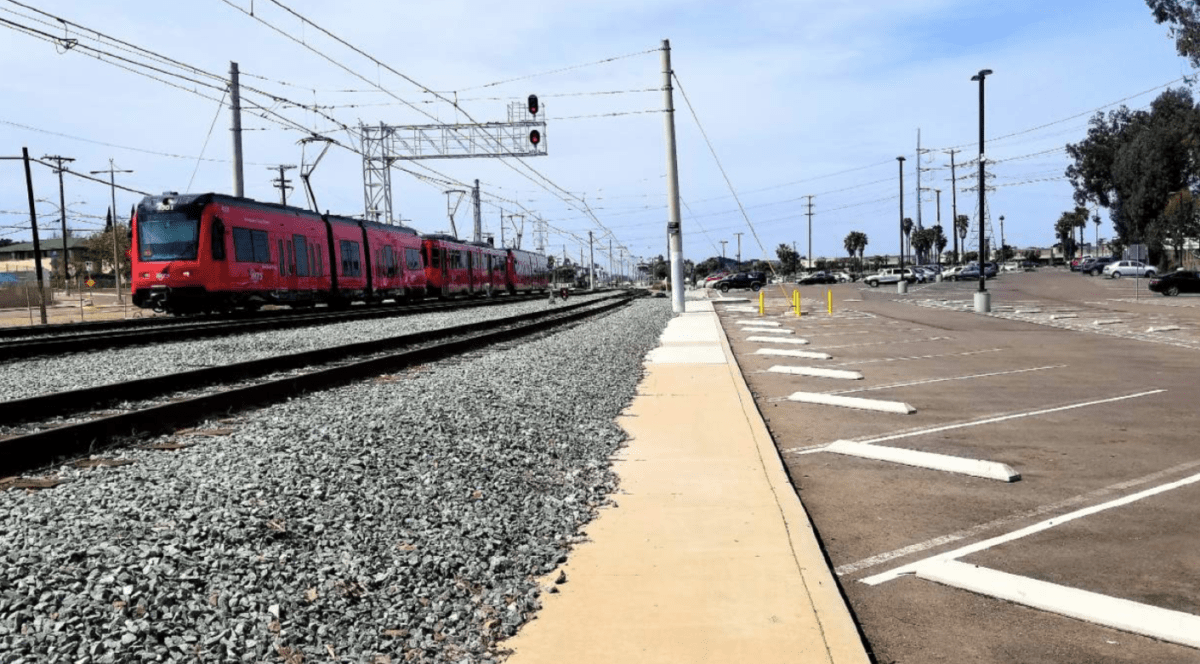
This guest post comes to us from Colin Parent, Executive Director and General Counsel at Circulate San Diego, a grassroots organization that advocates for better mobility choices and land use in Southern California. Circulate was a 2017 recipient of a TransitCenter dispatch grant.
America is drowning in parking. Fortunately, a growing number of transit agencies are developing strategies to repurpose underutilized lots near their stations into affordable homes. Research shows that people who can walk to transit use it the most, so building homes close to transit is in an agency’s self interest – and good public policy.
San Diego has an opportunity to put some of these ideas into practice. The San Diego region’s largest transit agency, the Metropolitan Transit System (MTS), owns a great deal of land, most of which is empty parking lots next to trolley and bus stations. Circulate San Diego recently released a report, “Real Opportunity,” with recommendations for developing this land into affordable homes. The report estimates that with proper land use regulations, those properties could support over 8,000 new homes, with more than 3,000 reserved as permanently affordable for low income families.
When it comes to joint development, MTS lags behind other California transit agencies. Los Angeles County Metropolitan Transit Authority, Bay Area Rapid Transit, and Santa Clara Valley Transportation Authority have all adopted policies to encourage mixed use development on transit agency land. As documented by Circulate’s report, these policies provide a model for MTS and other transit agencies to follow. The report focuses on California, but the practices it identifies are relevant for transit agencies nationwide.
Best Practice #1: Actively Solicit Development Proposals
California’s leading transit agencies post schedules for development projects in the pipeline, and active requests for proposals for new developments. While MTS has the authority to solicit proposals, the agency has not put that authority to use within the last decade. It should. MTS has developed a handful of properties through unsolicited proposals, but without competitive bids, transit agencies have little ability to judge how the market really values those development opportunities.
Similarly, establishing a schedule and public accountability are crucial for advancing development. Without a commitment by a transit agency to act on projects, they can be too easily persuaded to delay decisions and let valuable land near transit remain fallow. A public commitment to pursue development deals is a valuable signal to the market that the agency is serious, and it will encourage more diverse and more competitive proposals.
Best Practice #2: Require Affordable Homes
The second strategy used by leading transit agencies is to require permanently affordable homes to be included in any residential development. Every major city in California faces a housing affordability crisis, and development on public land should contribute to affordability. In San Diego, some of the MTS properties that have been developed include affordable units, but at varying levels. The Villa Encadada project, currently under construction, is a 67 unit affordable development. In larger projects, like the Alterra & Pravada at Grossmont Station (527 units) and the Morena Vista project (161 units), only fifteen and ten percent of homes are below market rate, respectively.
Low income families are more likely to ride public transit. Transit agencies have a clear incentive to ensure that any new development is affordable to core transit customers. Not only will higher ridership increase revenues to a transit agency, but they will also contribute to local greenhouse gas reduction commitments, which are common for jurisdictions in California.
Best Practice #3: Reduce Parking Replacement Requirements
Parking replacement requirements add significant cost to development on agency land. They also discourage transit use by easing car ownership. Developers are often required to replace the parking spaces that they build on top of, or to limit the size of their developments so that surface parking can be maintained.
MTS should revise their policies to reduce parking requirements, as other California transit agencies have done. A Smart Growth America study recently found that parking near transit stations often far outstrips demand, and Circulate’s report found similar usage rates at MTS properties. On lots near San Diego’s light rail system, the San Diego Trolley, parking averages can be as low as 20 percent utilization during peak hours.
Transit oriented development on transit agency land presents a real opportunity to help improve local economies, allow people to live and commute more affordably, and to reduce greenhouse gas emissions. That is why Circulate and affordable homes advocates are asking transit agency leadership on the MTS board to amend their policies on joint development, and encouraging other agencies to follow suit. Not only will development of underutilized real estate provide public benefits, but it will provide new sources of revenue to support improved transit operations for riders – a resounding win win.
 On the Brink: Will WMATA’s Progress Be Erased by 2024?
On the Brink: Will WMATA’s Progress Be Erased by 2024?
The experience of being a WMATA rider has substantially improved over the last 18 months, thanks to changes the agency has made like adding off-peak service and simplifying fares. Things are about to get even better with the launch of all-door boarding later this fall, overnight bus service on some lines starting in December, and an ambitious plan to redesign the Metrobus network. But all of this could go away by July 1, 2024.
Read More A Bus Agenda for New York City Mayor Eric Adams
A Bus Agenda for New York City Mayor Eric Adams
To create the “state-of-the-art bus transit system” of his campaign platform, Mayor Adams will have to both expand the quantity and improve the quality of bus lanes. We recommend these strategies to get it done.
Read More